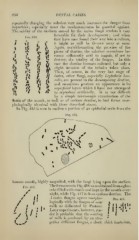Page 794 - My FlipBook
P. 794
804 DENTAL CARIES.
repeatedly changing the solution very much increases the danger from
impurities ; especially must the saccharomycetes be guarded against.
The acidity of the medium caused by the caries fungi renders it very
and when
favorable for their development ;
Fio. 414.
they have once found their way into a culture,
6
W V it might as well be thrown away at once.
I
.«; Again, notwithstanding the presence of the
pieces of dentine, the solution sometimes be-
comes sufficiently acid to impair, if not to
destroy, the vitality of the fungus. In this
it case the dentine becomes softened, but only a
II'
slight invasion of the tubules takes place.
I'
Then, of course, in the very last stage of
caries, other fungi, especially Lcptothrix buc-
I
': calls, are present in the decomposing dentine,
1} and sometimes produce an appearance in its
'1)
superficial layers which I have not attempted
to reproduce artificially. It is not difficult
il
by a simple microscopic examination of the
fluids of the mouth, as well as of carious dentine, to find forms mor-
phologically identical with those described above.
In Fig, 415 is seen in outline a portion of an epithelial scale from the
Fig. 415.
human mouth, highly magnified, with the fungi lying upon the surface.
Theformssecnin Fig. 416 were obtained fromaglass
Fig. 416.
tul)e filled with starch and kept in the mouth over-
night, while Fig. 41 7 is from carious dentine. The
.7 caries fungus agrees morpho-
/I ' ^xa. 417.
I logically with the fungus of sour
tU
milk as delineated by Pasteur.
I
Later experiments, however, ren- !
//' der it probal)lc that the souring I
of milk is ])roduced by an alto- *
^ ^/ gether diiferent fungus, a short, thick badenum,


